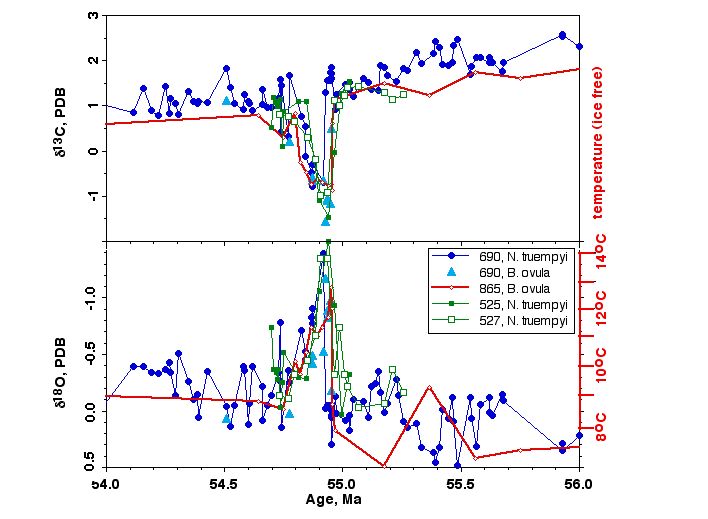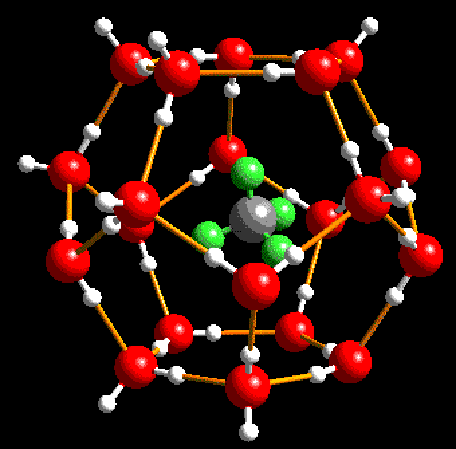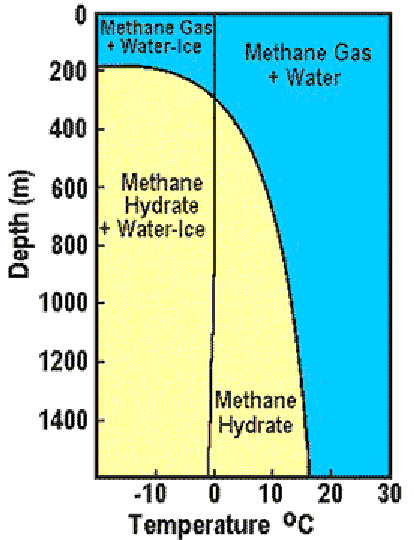E&ES 359: Climate
Change
return to index page
SNOWBALL
EARTH (or
Popsicle
Planet)
Web-readings:
There is considerable debate on the topics:
- Did Earth freeze over almost completely,
almost killing off all life, between about 850-550 Ma?
- Did Earth alternate between almost
frozen-almost boiling during that period?
- How can we use carbon isotopes
(see last
lecture) to find out what
happened at that time?
In order to find out, we need to revisit one
of the topics of last lecture: does the Cenozoic carbon and oxygen
isotope records:linkage of carbon cycle and climate? Specifically,
what do these
records show at about 55 Ma, which
might help us understand what happened during 'Snowball Earth'
episodes?
At 55 Ma, there were rapid carbon and oxygen isotope shift to low
values (occurring over a few thousands of years).

How to explain these rapid carbon isotope
shifts?
Whole ocean
d13C lighter by 2
o/oo, over a few thousand years. Whole deep
ocean warmer by ~ 5oC. (looks like fossil fuel buring).
The usual three possible causes do not work:
- Weathering of organic-rich rocks (oil,
coal) takes hundreds of thousands of years!
- Killing off whole biosphere: not enough
to have that much effect; no evidence.
- Volcanoes? Not rapid enough,
d13C
not light enough.
What we need to explain these isotope
changes is:
Source of 12C (such as organic
matter). From that source in the lithosphere, the carbon must be able
to escape into ocean-atmosphere rapidly.
Answer: Clathrates
(methane hydrate)
What are Methane Hydrates?
- Methane Hydrates are one example of
'clathrates'
- Clathrates are compounds which consist
of a 'cage structure', in which one type of molecule is trapped
inside a cage of other molecules; in this case: Methane
(CH4) is trapped in Water Ice
(H2O)

Grey=carbon
Green=hydrogen in CH4
Red = oxygen
White= hydrogen in H2O
Where does the methane in gas hydrates come
from?
Most common: bacterial degradation of
organic matter in low-oxygen environments (within sediments). Carbon
isotope composition: ~-60 o/oo
Where do clathrates occur? Wherever there
is:
- Methane (organic matter; in oceans
mainly close to continents (on continental margins) where
biological productivity is highest.
- Water
- Clathrate must be stable (ice): cold
and/or high pressure
How much methane is there in gas
hydrates?
Estimates vary; many indicate VERY large
amounts, of about 10,000 Gigaton carbon (1 Gigaton = 1015
ton), that is at least twice as much as the carbon in all known and
estimated fossil fuel (coal, oil, gas) reservoirs.
Hydrate Stability

If we could suddenly destabilize a large
amounts of methane hydrate ice, we would:
Rapidly add huge amounts of methane to the
atmosphere
- Methane is a strong green house gas, is
oxidized to CO2
- Positive feedback: blow up gas hydrates
-> liberate methane -> warms up earth -> blows up more
gas hydrates
So we would cause rapid and possibly extreme
global warming, which can be recognized in the rock record by a
large, negative 'spike' in d13C values in carbonates,
because bacterially produced methane in gas hydrates has very
negative d13C values.
Life on Earth
- Over 3.85 billion years, life on Earth
never became extinct
- All that time there must have been
liquid water on Earth
- Surface temperature of Earth between 0
and 100oC.
Thermostat of the Earth: BLAG model of long
carbon cycle.

But: did the thermostat work efficiently
when life was not very abundant?? Note that in the above figure
living organisms are a necessary link!
- In carbonate records, there are VERY
large variations in d13C, >500 Ma
- Did that indicate unstable
climate?
There is considerable evidence for 'strange'
climate: SNOWBALL EARTH (or rather: freeze-fry Earth)
- 605-595 Ma: Marinoan Glacial (SNOWBALL
II); 700-690 Ma: Sturtian glacial (SNOWBALL I)
- Glacial deposits at low latitudes
(paleomagnetic evidence) and at low altitude (sea
level)
- VERY rapid changes from very cold to
very warm climate
Development of Snowball Earth
hypothesis:
Stage 1: Snowball Earth
Prologue
- Breakup of a single land mass ~770 Ma:
small continents near equator, high rainfall.
- Rapid weathering of rocks (wet); CO2 out
of atmosphere.
- No burrowing animals; organic carbon
produced, does not get from sediments back into oceans
- Ice packs at poles; ice reflects solar
energy-> even colder ( + feedback)
- Planet iced over within a
millennium.
Stage 2: Snowball Earth at its
Coldest
- Global temperatures to -50oC
; oceans ice over (to what depth?), limited by heat from Earth's
interior.
- Much life dies; simple life forms
survive at hot springs.
- Cold and dry: stops growth of land
glaciers; dry: not much weathering.
- No more photosynthesis: oceans iced
over; d13C values get more negative (to
~-6o/oo, volcanic values)
- Oceans go anoxic
- CO2 emitted from volcanoes is
not removed from the atmosphere; planet warms, sea ice
thins.
Stage 3: Snowball Earth as it
Thaws
- CO2 increases 1000 fold
in ~10 million years (volcanoes): warming.
- Moisture feeds land glaciers; they
grow
- Open water in tropics: less heat
reflected back into space -> fast rise in global temperatures.
- In centuries: a brutally hot, wet
world
Stage 4: Hothouse
Aftermath
- Oceans thaw, sea water evaporates, water
vapor with CO2 produces intense greenhouse
- Temperatures to ~50oC,
intense evaporation, rainfall.
- Rivers: ions into the oceans, form
carbonate sediments.
BUT: does the record support this? Do carbon
isotope values show the expected pattern: very low values during the
coldest stage, when the oceans were iced over and there could not be
any photosynthesis?
- Negative d13C values NOT in
glacials (very few data available), but directly above, in
carbonates
- 'Cap carbonates' have structures as
limestones in contact with gas hydrates, and very low carbon
isotope values.
- Carbon isotope swings: gas hydrate
dissociation: as earth warms out of the snowball stage, gas
hydrates dissociate as the oceans begin to warm slightly, and
cause + feedback, rapid and extreme warming. The oceans were
probably never fully frozen over (no need to fully stop
photosynthesis: low carbon isotope values explained by methane
hydrate dissociation, not by total end of
photosynthesis).
Snowball Earth Review:
- Good evidence for extreme climate swings
(hot to cold), cold extreme (ice in tropics)
- Not clear to which depths, over how much
area, oceans were frozen: climate models say tropics remained open
sea
- Life forms: 750-580 million years ago
there were large (up to ~ 3 ft), multicellular organisms
( which are called Vendobionta: 670-545 Ma). If oceans froze
until depths of 1000 m: Vendobionta would not have survived, which
they did.
- 'Slushball' Earth: oceans at least
partially ice-free




